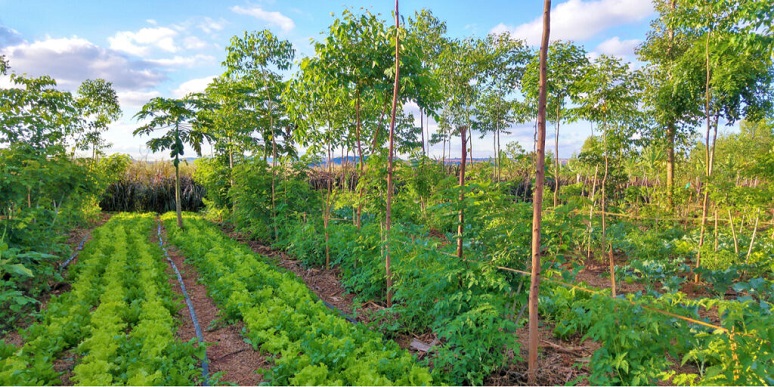
-
Phone:
+91 934 567 891 -
For Investments:
investment@farmmyland.in -
For Partnerships:
partnerships@farmmyland.in

As the demand for food, timber, and ecological conservation rises, conventional farming methods are struggling to keep up. Deforestation, soil degradation, and erratic climate patterns threaten agricultural productivity, making sustainable solutions a necessity. One such solution gaining momentum in India is agroforestry—a land-use management practice that integrates trees, crops, and livestock to create a synergistic ecosystem that benefits farmers, the environment, and local communities.
At Farm My Land, we recognize agroforestry as a revolutionary farming approach that enhances soil fertility, increases biodiversity, and boosts farmer income. In this article, we explore the concept of agroforestry, its benefits, challenges, and how it can reshape India’s agricultural landscape.
Agroforestry is a scientific and sustainable land-use system that combines trees, shrubs, crops, and livestock on the same piece of land. Unlike monoculture farming, where only one type of crop is grown, agroforestry creates a diverse ecosystem that mimics natural forests while ensuring agricultural productivity.
There are several types of agroforestry systems, including:
Each system is designed to maximize land efficiency, conserve natural resources, and provide economic benefits to farmers.
Deforestation and unsustainable farming practices have led to widespread soil degradation and loss of biodiversity. Agroforestry restores soil health by:
With rising input costs and fluctuating crop prices, Indian farmers face financial uncertainty. Agroforestry offers multiple revenue streams, including:
By diversifying income sources, agroforestry reduces financial risk and improves rural livelihoods.
Traditional farming relies heavily on groundwater, leading to water scarcity. Agroforestry optimizes water use by:
This ensures sustainable water management, benefiting both farmers and the environment.
Agroforestry creates a natural habitat for birds, bees, and beneficial insects. Increased biodiversity improves pollination efficiency, resulting in higher crop yields and ecosystem stability.
For farmers involved in animal husbandry, agroforestry offers a sustainable grazing system where livestock can feed on tree fodder, reducing dependence on expensive commercial feed. This lowers costs and improves animal nutrition, leading to higher-quality dairy and meat production.
Agroforestry systems act as natural windbreaks and temperature regulators, reducing crop damage from storms, heatwaves, and floods. Trees provide shade and shelter for crops and animals, minimizing heat stress and increasing resilience to climate change.
The Indian government has recognized the importance of agroforestry and introduced policies to encourage its adoption.
Farmers looking to adopt agroforestry can leverage these government schemes to access financial and technical support.
Despite its benefits, agroforestry adoption faces several challenges:
Unlike traditional crops that provide quick returns, trees take years to mature, requiring patience and long-term investment.
Many farmers are unaware of agroforestry’s benefits. Lack of technical knowledge on species selection, planting techniques, and market linkages hampers adoption.
In some regions, unclear land ownership rights create challenges in tree plantation, as farmers fear losing control over their land.
Although agroforestry is profitable in the long run, initial costs for seedlings, irrigation, and labor can be a barrier for small-scale farmers.
At Farm My Land, we are addressing these challenges by providing training, financial guidance, and expert support to farmers interested in agroforestry.
As pioneers in sustainable land-use management, we at Farm My Land are committed to expanding agroforestry across India. Our initiatives include:
Our goal is to empower farmers, investors, and environmentalists to embrace agroforestry as a profitable and sustainable solution for India’s agricultural challenges.
With rising climate concerns and depleting natural resources, agroforestry is no longer an option—it is a necessity. The future of Indian agriculture will depend on eco-friendly farming methods that prioritize sustainability, productivity, and biodiversity conservation.
By integrating agriculture and forestry, we can restore ecological balance, increase farmer profitability, and ensure food security for future generations.
Agroforestry is a powerful tool for achieving sustainable agriculture, environmental conservation, and economic growth. It offers climate resilience, higher yields, and multiple revenue streams, making it an ideal solution for Indian farmers facing soil degradation, water scarcity, and financial instability.
At Farm My Land, we are committed to bringing agroforestry to the forefront of India’s agricultural revolution. By fostering innovation, providing training, and connecting stakeholders, we aim to create a greener, more prosperous future for Indian farmers.
Join us in transforming Indian agriculture through agroforestry.